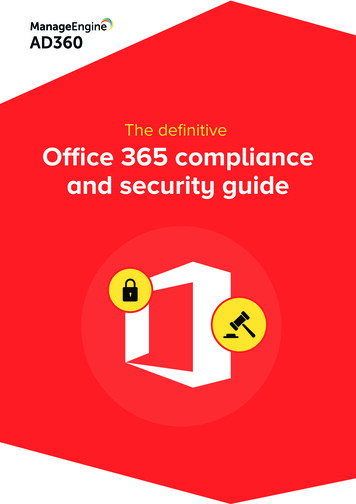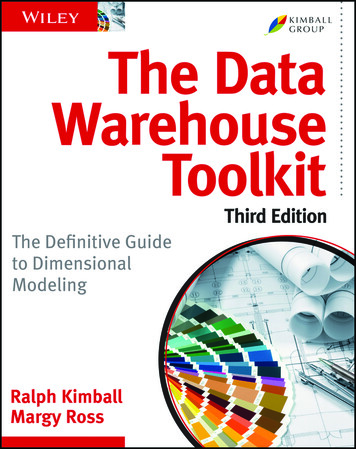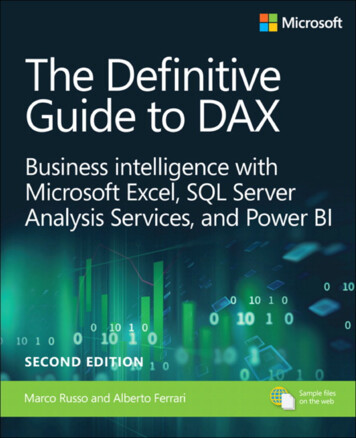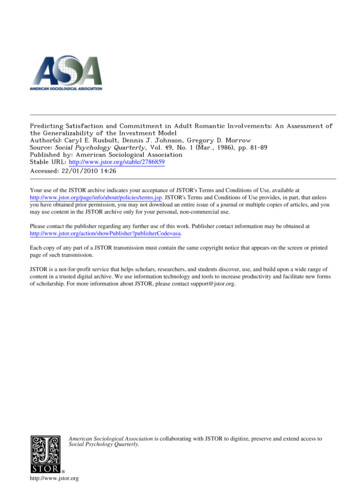
Transcription
The definitiveOffice 365 complianceand security guide
Table of contents1. Introduction12. AD360: Your Office 365 compliance and2security management tool3. Compliance is a click away with AD36023SOX3FISMA3GLBA3HIPAA3PCI DSS34. Overcoming security challenges with AD36054.1 Detecting spam and malware54.2 Monitoring DLP policy matches75. Office 365 security reports86. Get critical alerts for OneDrive for Business,6Sway, Yammer, and Microsoft Teams7. Summary1315
1. IntroductionAs an IT administrator, your biggest concerns are keeping your organization secureand meeting compliance requirements. But what are security and compliance?Let's start by taking a deeper look at each of these terms and how they differ fromeach other.Security is the practice of protecting the integrity and confidentiality of the criticalbusiness information and assets in your possession. Compliance, on the otherhand, involves taking steps to ensure your digital resources are protected, and ismainly the process of adhering to the requirements set by third parties, includinggovernment regulations, terms of a contract, and security frameworks. In short,compliance is a measure adopted to prove that your network is secured.A common misconception among organizations is that if their setup is compliant,it also means that they're secure. We've seen organizations such as Home Depotand Target suffer huge data breaches despite being PCI-compliant. So what shouldorganizations focus on instead to ensure security?The main focus for any business is to protect the confidential data in its possession,as any loss of data can destroy an organization's reputation, leading to huge costsin damages. To protect confidential data, both compliance and security are equallyimportant. Every organization needs to combine a strong security program with acompliance plan to reduce the risk of data breaches.AD360 is an extensive Office 365 tool that helps you comply with various ITcompliance mandates as well as mitigate any security threats looming over yourOffice 365 setup.1
2. AD360: Your Office 365 complianceand security management toolAD360 is a comprehensive Office 365 reporting, auditing, monitoring, management, andalerting tool. Its user-friendly interface makes it easy to manage Office 365 services such asExchange Online, Azure Active Directory, Skype for Business, OneDrive for Business, and MicrosoftTeams, all from a central console (Figure 1).AD360 provides over 700 preconfigured reports that consolidate data from your Office 365components, giving you complete visibility into your Office 365 setup. You can monitor Office 365services around the clock, and receive instant email notifications about service outages. It alsoeases compliance management with built-in compliance reports, and offers advanced auditing andalerting features to keep your Office 365 setup secure.Figure 1. AD360's dashboard.2
3. Compliance is a click awaywith AD360Organizations have to implement various control methods to comply with different industrymandates. AD360 keeps tabs on all user and admin activities in your Office 365 environment, so youcan comply with regulatory mandates such as SOX, HIPAA, PCI DSS, GLBA, and FISMA. For detailedcompliance reporting, we have compiled checklists of the required control methods for some ofthe most important compliance mandates.Figure 2. Prebuilt compliance reports mapped to their respective compliance regulations.3
3.1 ChecklistsUsing AD360's compliance reports, you can keep your organization's information safe and meet therequirements of various compliance standards.Download SOX complianceDownload FISMA complianceDownload GLBA compliancechecklistchecklistchecklistDownload HIPAA complianceDownload PCI DSS compliancechecklistchecklistNote: The procedures for establishing compliance may vary depending on your systemsconfiguration, internal procedures, the nature of your business, and other factors.4
4. Overcoming security challengeswith AD360AD360 offers a wide array of features to ensure the security of your Office 365 environment.4.1 Detecting spam and malwareAD360 provides the following capabilities to detect spam and malware in your Office 365 setup:Comprehensive monitoring of all inbound and outbound traffic in yourExchange Online environment.Custom summary audit views for faster threat detection.Scheduled reports for all spam and malware information for regularsecurity audits.Alert notifications that help with early detection.4.1.1 AuditingAD360 detects spam and malware in emails and provides detailed information such as sender,subject, and recipient, as shown in Figure 3.Figure 3. AD360 spam detection.5
4.1.2 Creating custom viewsUsing AD360, you can set custom views for audit summaries based on spam/malware senderaddress, spam/malware recipient address, domain, and more, as shown in Figure 4. These customviews make monitoring quicker and more convenient.Figure 4. Creating a custom spam and malware detection summary view.4.1.3 AlertingAD360 can send notification messages to admins containing details about the spam/malwaresender's email address, recipient's email address, subject of the spam email, and more, as shown inFigure 5. With this information, you can take immediate action after discovering an attack.Figure 5. Spam alerts.6
4.1.4 ReportingUsing AD360, you can generate various reports on spam and malware in emails, including:Top Spam RecipientsTop Malware RecipientsMalware DetectionsSpam Detections4.2 Monitoring DLP policy matchesAD360 helps prevent data loss via email by monitoring and investigating email traffic. It helps you:Gather information from the data loss prevention (DLP) policy matchesreport, or set DLP policy match alerts to prevent sensitive information frombeing compromised.Filter the DLP policy matches based on time, sender, recipient, and more tobetter understand the trends and reasons for data loss.4.2.1 Auditing and alertingOne way AD360 detects data loss is by identifying emails that match DLP policies. If an emailcontains data matching the policy, AD360 provides all details about the email, including the sender,recipient, subject, domain information, and the DLP policy that's matched to it.Figure 6. Auditing DLP policy matches.7
Figure 7. DLP policy match alert configuration.5. Office 365 security reportsAD360 provides the following categories of reports to comprehensively monitor and strengthenthe security of your Office 365 environment:Activity reportsUser and mailbox security reportsAD360 also helps you comply with the stringent requirements of IT compliance regulatorymandates like PCI DSS (requirement 10.2.2 and 11.5), ISO 27000 (requirement A.12.4.3), SOX(section 404), HIPAA (section 164.308 (a)(1)(ii)(D)), and FISMA (NIST SP800-53), by keeping tabs onall administrator and user activities in your Office 365 environment.8
5.1 Activity reportsMost organizations delegate administrative responsibilities among different admins and sometimesneed to elevate a user's rights. Activity reports let you know when admins, users with elevatedrights, or any other users make critical changes in your Office 365 environment, so you can easilyidentify unauthorized modifications.5.1.1 Admin ActivitiesGet a comprehensive overview of all administrator activity in your Office 365 environment withreports on:Exchange Admin ActivityAzure Admin ActivityHold activity5.1.1(a) Exchange Admin ActivityThis report provides an overview of all administrators' activities in your Exchange Onlineenvironment, such as what activity was performed, who performed the activity, the status of theoperation, and which objects were modified.Figure 8. Exchange Admin Activity report.9
5.1.1(b) Azure Admin ActivityThis report helps you monitor, audit, and report on Azure administrators' activities, and ensure theintegrity and security of your organization's Azure environment.Figure 9. Azure Admin Activity report.5.1.1(c) Hold activity reportsPlacing a hold on a mailbox retains emails for either a specific period of time or indefinitely. Thisensures that all emails are retained and left unaltered for legal purposes. Any alteration can causehuge legal ramifications, so it's important to closely monitor every change made to hold objects.AD360's hold activity reports provide details on all changes made to InPlace Hold and LitigationHold objects, including information on the change, the person responsible for the change, theparameters changed, and the status of the change.5.1.1(c)(i) Litigation Hold ActivityThis report provides details on all changes made to the Litigation Hold on mailboxes, as shown inFigure 10. These details include what object was modified, what activity was performed, and whomade the change.Figure 10. Litigation Hold Activity report.10
5.1.1(c)(ii) InPlace Hold and eDiscovery ActivityAD360 helps you identify all changes made to InPlace Hold objects, including information on thechange, the administrator responsible for the change, and which parameters were changed. Thisreport also provides details on all InPlace eDiscovery searches meant to search for content fromyour Exchange mailboxes.Figure 11. InPlace Hold and eDiscovery Activity report.Figure 12. Mailbox Login Activities report.5.1.2 User ActivitiesAD360 provides reports on Exchange user activities, such as mailbox logins, along with details onwho performed the activity, what activity was performed, status of the activity, client IP address, andmore.You can also monitor the activities performed by mailbox delegates and mailbox non-owners, aswell as send as activities; mail, move, and delete activities; and more.11
Figure 13. Exchange User Activities report.5.2 User and mailbox security reportsAD360 provides an array of user and mailbox security reports to enhance the security of your Office365 setup. With these reports you can:See which users were added and removed from admin roles to preventunintended users from gaining privileged roles.View details on users who have access to shared mailboxes, as well as the typeof access rights they have. This helps ensure correct permissions are grantedonly to desired users.Find passwords that are set to never expire in your Office 365 setup so you cantake corrective action.And more.Figure 14. Mailbox and user security reports.12
6. Get critical alerts for OneDrive for Business,Sway, Yammer, and Microsoft Teams6.1 OneDrive for BusinessWith AD360, you can set customized alerts for OneDrive file and folder, sync, and sharing activities,along with the severity of the action performed, as shown in Figure 15.Figure 15. OneDrive for Business file sharing alerts.6.2 SwayAD360 lets you audit and set alerts for various activities such as Sway creation, modification,duplication, deletion, and external sharing.Figure 16. Set alerts for various actions performed in Sway.13
6.3 YammerAD360 helps get details about various admin activities, such as modifications to securityconfigurations, delete settings, and private content mode. You can also view details on useractivities including file sharing and message deletion.Figure 17. Set alerts for various user and admin actions in Yammer.6.4 Microsoft TeamsAD360 helps you audit events and setting changes in Microsoft Teams and raises alerts for theseactions, as shown in Figure 18.Figure 18. Set alerts for various actions performed in Microsoft Teams.14
7. SummaryWith AD360's comprehensive Office 365 compliance and security module, you can:Generate reports for IT compliance regulations.Monitor email traffic to detect spam and malware.Run reports on Exchange and Azure admin activities, litigation holds, and more.Detect loss of sensitive data for faster disaster recovery.Get critical alerts on OneDrive for Business, Microsoft Teams, Yammer,Sway, and more.About AD360AD360 is an integrated identity and access management (IAM) solution for managing user identities, governing accessto resources, enforcing security, and ensuring compliance. From user provisioning, self-service password management,and Active Directory change monitoring, to single sign-on (SSO) for enterprise applications, AD360 helps you performall your IAM tasks with a simple, easy-to-use interface.With AD360, you can just choose the components you need and start addressing IAM challenges across on-premises,cloud, and hybrid environments from within a single console.
AD360 lets you audit and set alerts for various activities such as Sway creation, modification, duplication, deletion, and external sharing. 6.2 Sway Figure 15. OneDrive for Business file sharing alerts. Figure 16. Set alerts for various actions performed in Sway. 13











